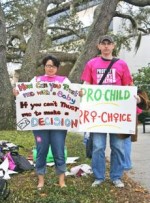Pro-life protest shocks USF

Students walking between Russell M. Cooper Hall and the Library Wednesday and Thursday were confronted by six-foot graphic images of bloody aborted fetuses, Holocaust victims and lynched slaves.
The display was part of The Center for Bio-Ethical Reform’s (CBR) Genocide Awareness Project (GAP), a traveling photo exhibit that juxtaposes images of abortion with images of the Holocaust and American slavery to argue against abortion.
University Police were on standby at the display, which was enclosed by a metal fence, as violence broke out during the CBR’s visit to USF nine years ago when a protestor threw acid at a GAP volunteer.
There were no arrests and no injuries.
Voices for Planned Parenthood (VOX) and the Feminist Student Alliance (FSA) protested the display, which some felt trivialized the Holocaust.
“It’s wrong to compare (abortion) to genocide,” said Erica Rodriguez, 19, a member of the FSA. “I don’t think expelling a fetus is the same as killing people over religious or economic reasons. They are degrading these tragic events and calling women perpetrators of genocide.”
Alex Southard, president of VOX, described the display as a “misappropriation of images taken out of context.”
“We think this is appalling,” she said.
Some onlookers, who were shocked by the display and even opposed to its premise, agreed that CBR had a First Amendment right to organize and share its beliefs.
“It’s a little offensive on either side, but at the same time, it’s their right to do it,” said chemistry and biology major Ryan Valdes.
CBR has brought GAP to public forums such as universities across the country with little resistance, supporters said.
Mike Schrimscher, who has been working with CBR – which was established in 1990 – for five years, could only recall one instance in which it faced legal problems.
“Only (Indiana University) tried to stop us. (CBR) sued in federal court and hasn’t had a problem since then,” he said.
Schrimscher, who agreed that the CBR’s display is shocking, said the unusual and controversial reaction is exactly what it is seeking.
“It’s one of the few organizations that confronts the culture,” he said. “At one time Americans believed that society couldn’t function without slavery. Now slavery is unthinkable. Most people, if offered a slave, wouldn’t accept one. That’s what we’re trying to do with abortion. You have to change society’s opinion to change legislation,” he said.
The CBR has organized similar displays at the University of Tennessee, Ohio University and the University of Michigan-Ann Arbor, receiving praise from anti-abortion student organizations along the way, he said.
The CBR runs two similar campaigns in addition to GAP. The Reproduction “Choice” Campaign uses 8-by-22 panel trucks mounted with the same graphic abortion photos found in the GAP.
According to abortionno.org, the purpose of the trucks is to contrast the reality of abortion “with its abstraction” – people’s right to choose.
Matthew 28:20 and Mini-GAP are both smaller versions of the GAP exhibit. Matthew 28:20 focuses on religious communities, organizing protests outside local churches that the CBR claims “trivializes or ignores baby-killing.”
Since GAP is an expensive and time-consuming anti-abortion demonstration, Mini-GAP was launched in hopes of starting a grassroots movement. All of the photos from GAP are available online for purchase, a move that seeks to fulfill one of the CBR’s main goals, which, according to Schrimscher, is to “spread the truth about abortion worldwide.”






